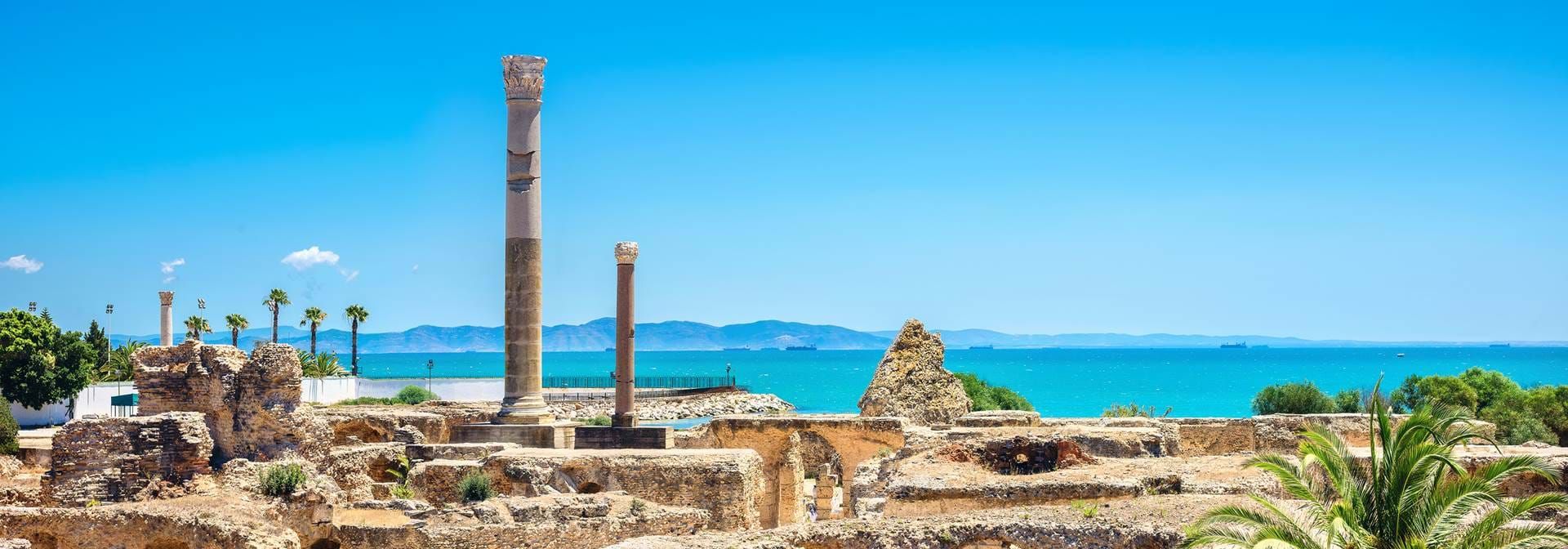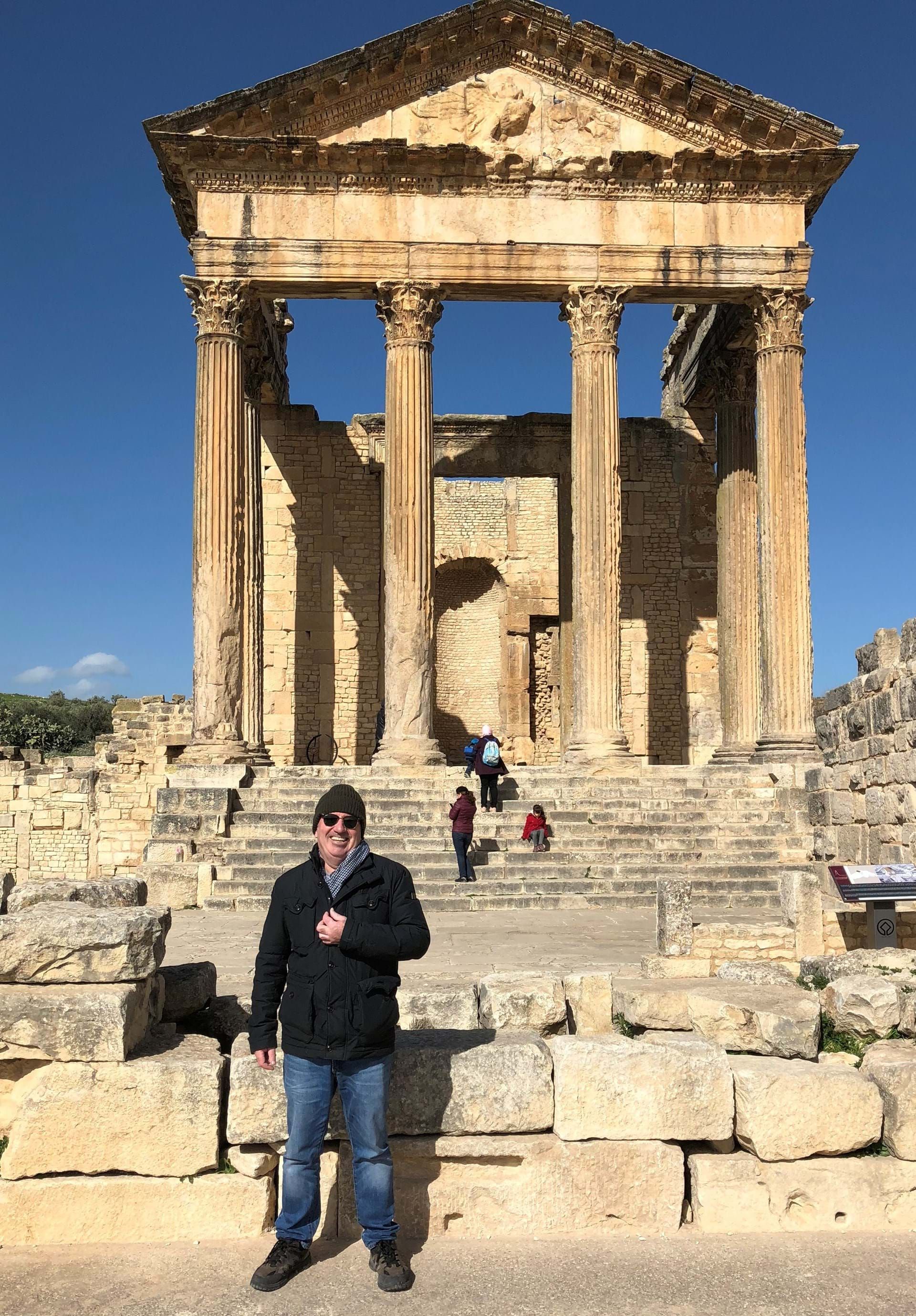Archaeology in North Africa

There are many archaeological sites in Tunisia to explore and our Guide Lecturer Tony O’Connor is an expert on them. He has been leading tours for us for over two decades now and cherishes every chance he gets to return to this magnificent country, offering incredible insight into Tunisia’s archaeology and its rich history to curious guests from all over the world.
Tony wrote a piece for us on his experiences guiding tours in Tunisia and the sites that makes this destination so alluring for the archaeological traveller, and you can join him in on one of our award-winning Tunisia tours this year and next. Without further ado, here’s more from Tony.
This is a land where dramatic events shaped ancient history – the superpowers of Carthage and Rome clashed in three Punic Wars, which determined the course of Western history. Lasting more than 100 years, the conflict ultimately resulted in the destruction of Carthage and assured Roman ascendancy. Join us to explore the ruins of the Roman era in the beautiful, verdant North African countryside. Travel from the ruins of Carthage itself to the magnificent Roman cities and monuments of Roman Tunisia: the amphitheatre at El Djem, the beautiful, remote site of Dougga and vast intricate mosaics. These all bring the world of Roman Africa vividly to life. In 2020 we were finally able to return to Bulla Regia, with its characteristic underground houses. The site covers more than 60 hectares with its range of Berber, Roman and Numidian archaeological influences.
On March 11th, 2020, I touched down in London at the end of our tour of Tunisia – The Punic Wars, a tour I have been leading for Andante now for over 20 years and which for me still has a special magic as do most of Andante’s North African tours.
My first experience of North Africa was as an archaeologist working on the UNESCO Libyan valleys survey project in the early 1980’s, this introduced me to the major Roman period cities of Lepcis Magna and Sabratha as well as the farmsteads, tombs and agricultural landscape of the Libyan pre-desert. It was here, too, where my admiration and recognition of the importance of the role of the Phoenicians’ to the creation of the Classical world in both the eastern and western Mediterranean first took root.
Working in the Libyan desert and witnessing how ancient communities were able to manage limited water resources to literally ‘farm the desert’ increased my respect for the people able to create a living in this arid landscape. It also has led to a long-time love of the desert, despite the dangers of; sandstorms, flash floods, venomous snakes and scorpions when excavating sites. Not the kind of health and safety issues you have to think about when digging in Britain!
The kindness and hospitality of the local people of the desert always stands out for me; the shepherd boy offering to share his water with colleagues and myself while surveying a rural site. The local village lads, who challenged the British archaeologist to a game of football and convincingly beat us; or the family in a small remote village which I was taking a group to, giving us their house to use for a picnic.
In the 1990s I returned to work in eastern Libya, at the Hellenistic port city of Ptolemais. Near to the great city of Cyrene. I spent three wonderful seasons at this amazing and yet little know site. Around this time, I was able to visit sites and undertake research in Northern Egypt and Tunisia exploring the trade and cultural links which extended in antiquity right along the North African coastline.
Across North Africa, while Libya has the surviving great Imperial cities, Tunisia, where the capital Carthage was situated, is the region which lies at the heart of the story. Here we can follow the rise and fall of Punic (western Phoenician) Carthage from its foundation in 814 BC to its destruction in 146 BC to be replaced by a new Roman capital under Augustus in 29 BC.
On the Tunisia tour, it is at Carthage, the stunning Bardo museum and on Cap Bon that we mainly encounter the much-maligned Phoenicians. The nature of the infant burials and their association with child sacrifice at the ‘Salammbo Tophet’, is still a hotly debated subject.
At Byrsa Hill we see a residential quarter built by Hannibal Barca when he ruled the city in the years following the end of the second Punic war, one of the few places where we can stand in the footsteps of the great Carthaginian general.


Tunisia, Libya, Egypt and Algeria were some of the richest provinces of the Roman empire and here we gain a picture of the prosperous world of the high empire (1st to 3rd centuries AD), when the process of Romanisation was at its height. Our return this year in Tunisia to Bulla Regia, where the houses of the wealthy had underground rooms complete with fine mosaics and gardens, is a reminder of the sophistication of life in these urban communities.
The extensive range of coloured figurative mosaics we find across North Africa and particularly in Tunisia are further evidence of the wealth of the province, the skill of its mosaicists and the level of Romanisation adopted across the region is stunning.
One of the things that strikes when leading tours here, are the way the sites lend themselves to parallels with events in the contemporary world. I remember, in 2008 when the great financial crash broke, taking a group to Lepcis Magna, its magnificent imperial building project of forum, basilica, colonnaded streets and harbour, built by local boy turned emperor Septimius Severus, of which the cost it is estimated contributed to the financial collapse of the Roman state at the beginning of Rome’s 3rd century crisis and ended up being an expensive ‘white elephant’, majestic though it is today.
In Tunisia, at El Djem, we see the remains of a prosperous Roman town and stunning amphitheatre, which at the beginning of the crisis rose in revolt against increasing taxes and was the catalyst for a series of events which brought the ‘Golden Age’ of Roman north Africa and much of the Roman world to an end, helped along by political instability and a pandemic (the Antonine plague), which had decimated the population of the Roman world. I am looking forward to exploring and sharing these amazing sites again on future tours.
Archaeology Tours
NEWSLETTER
Opt-in to our email newsletter and hear about new offers first – view our privacy policy for details.


